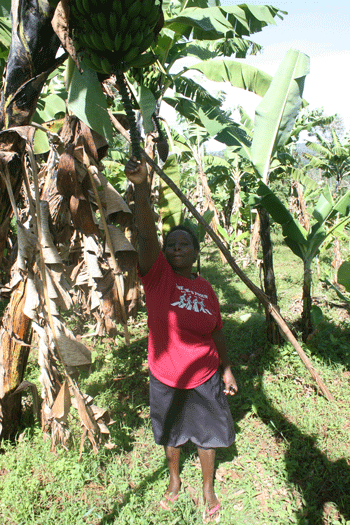
Indigenous bananas easier to grow as compared to tissue culture bananas
A visit to Kisii County, takes us to the lush terrain of Kenyenya Village, Bomachoge Borabu Constituency. Here, we meet Jackline Kemunto who has briskly coined indigenous bananas cultivation as her lifelong employment since 2007.
Equipped with thorough knowledge on banana farming while working at her father’s farm, Kemunto tried to give it a try on her two acres’ piece of land, and she describes the farming journey as splendid. “Most people in this area are known for cultivating maize and beans but I decided to do something different and hence settled on bananas as this climate befits their cultivation,” she said.
Juggling between motherhood and farming, she opines that serious farming is no longer a preserve of men. “Hard economic times hits all of us but us women are affected more due to the important roles we play. When a child is out of school due to lack of school fees or goes to bed hungry, we are more affected, thus why I am serious in farming,’’ she said. Besides bananas, she grows kales, cabbages and indigenous vegetables for her own consumption.
“To grow good bananas, dig 3ft by 2ft deep holes; bananas should be planted deep for good anchorage. This also helps to prevent premature emergency of suckers. While planting, I put in a hole one wheelbarrow of manure and two handfuls of inorganic fertilizer, which I mix thoroughly with soil,” she avers.
The spacing from one banana to the other is 13ft by 12ft. A larger spacing is disadvantageous especially for places with water shortage as it does not allow the formation of a canopy. “A large spacing also necessitates more staking to stop the bananas from falling. But with a spacing of 13ft by 12ft, staking is minimal, the canopy forms fast at eight months and water doesn’t dry fast on the ground,” says Kemunto, who has over 1,000 banana plants.
At eight months, she applies two wheelbarrows of manure per banana and spreads it around the crop; she rears livestock thus she has animal manure in large quantities “My bananas normally flower at eight months and produce a lot of suckers due to good husbandry,” she said.
The plant starts to produce fruits after about a year and harvesting sets in after six months. Currently, she says she harvests five tons of bananas for cooking and ripening. “I harvest bananas all-year-round. While some are being harvested, others are being planted. I get suckers for planting from my own farm,” she narrated.
Kemunto sells her bananas mainly to traders in Nairobi, earning at least
Sh30, 000 per month from her two acres. She says that with proper care and management, one banana can retail at ksh 500. To be able to make good money, she employs cultural methods and practices proper crop husbandry.
She ensures the crops are well spaced and that there is no wetness on the farm to curb diseases. Through proceeds from bananas, she is able to educate her children and has constructed a permanent house. Kemunto has been able to employ three casuals who assist her in the daily operations of her farm, thus economically empowering others.
“Indigenous banana are easy to grow and maintain as compared tissue culture bananas though they don’t yield much as compared to tissue culture bananas. They are not susceptible to many pests, diseases, and are strong enough to withstand wind though I usually support them. They do not easily crack when they fall to the ground and their post-harvest loses are minimal.,” she stated.
Optimally, according to National Farmers Information Service (NAFIS), bananas are the world’s fourth most important food commodity, after rice, wheat and maize. Hence, when one invests in their cultivation, there is a huge populace to feed as well as a wider market in the region.

